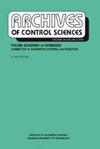Stability analysis of engineering/physical dynamic systems using residual energy function
IF 1.1
4区 计算机科学
Q4 AUTOMATION & CONTROL SYSTEMS
引用次数: 2
Abstract
In this article, an engineering/physical dynamic system including losses is analyzed in relation to the stability from an engineer’s/physicist’s point of view. Firstly, conditions for a Hamiltonian to be an energy function, time independent or not, is explained herein. To analyze stability of engineering system, Lyapunov-like energy function, called residual energy function is used. The residual function may contain, apart from external energies, negative losses as well. This function includes the sum of potential and kinetic energies, which are special forms and ready-made (weak) Lyapunov functions, and loss of energies (positive and/or negative) of a system described in different forms using tensorial variables. As the Lypunov function, residual energy function is defined as Hamiltonian energy function plus loss of energies and then associated weak and strong stability are proved through the first time-derivative of residual energy function. It is demonstrated how the stability analysis can be performed using the residual energy functions in different formulations and in generalized motion space when available. This novel approach is applied to RLC circuit, AC equivalent circuit of Gunn diode oscillator for autonomous, and a coupled (electromechanical) example for nonautonomous case. In the nonautonomous case, the stability criteria can not be proven for one type of formulation, however, it can be proven in the other type formulation.用剩余能量函数分析工程/物理动力系统的稳定性
在这篇文章中,从工程师/物理学家的角度分析了一个包括损失的工程/物理动态系统与稳定性的关系。首先,本文解释了哈密顿函数是与时间无关的能量函数的条件。为了分析工程系统的稳定性,采用了类李雅普诺夫能量函数,即剩余能量函数。除外部能量外,残差函数还可能包含负损失。这个函数包括势能和动能的总和,它们是特殊形式和现成的(弱)李雅普诺夫函数,以及使用张量变量以不同形式描述的系统的能量损失(正和/或负)。作为Lypunov函数,将剩余能量函数定义为哈密顿能量函数加上能量损失,然后通过对剩余能量函数的一次导数证明其弱稳定性和强稳定性。演示了如何使用剩余能量函数在不同的公式和广义运动空间中进行稳定性分析。将该方法应用于RLC电路、Gunn二极管振荡器的交流等效电路和非自治情况下的耦合(机电)算例。在非自治情况下,一种形式的稳定性判据不能被证明,而另一种形式的稳定性判据可以被证明。
本文章由计算机程序翻译,如有差异,请以英文原文为准。
求助全文
约1分钟内获得全文
求助全文
来源期刊

Archives of Control Sciences
Mathematics-Modeling and Simulation
CiteScore
2.40
自引率
33.30%
发文量
0
审稿时长
14 weeks
期刊介绍:
Archives of Control Sciences welcomes for consideration papers on topics of significance in broadly understood control science and related areas, including: basic control theory, optimal control, optimization methods, control of complex systems, mathematical modeling of dynamic and control systems, expert and decision support systems and diverse methods of knowledge modelling and representing uncertainty (by stochastic, set-valued, fuzzy or rough set methods, etc.), robotics and flexible manufacturing systems. Related areas that are covered include information technology, parallel and distributed computations, neural networks and mathematical biomedicine, mathematical economics, applied game theory, financial engineering, business informatics and other similar fields.
 求助内容:
求助内容: 应助结果提醒方式:
应助结果提醒方式:


